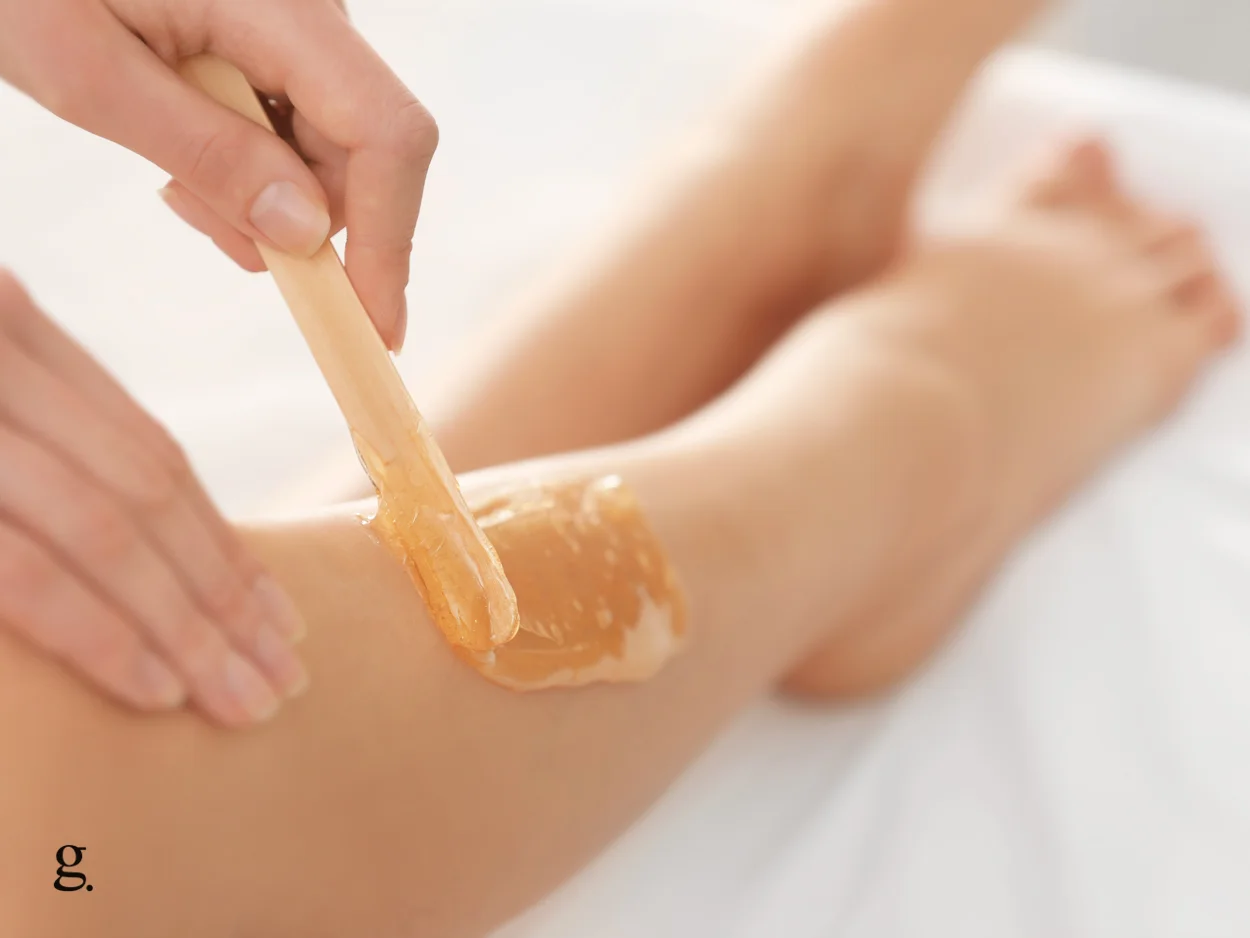Oh, honey, we’ve all been there—eager for that silky smooth skin but dreading the pain that comes with waxing. But fear not my fellow beauty buffs! It’s possible to get the job done without wincing at every pull. This article is your go-to guide on how to avoid pain while waxing, so you can strut your stuff without shedding any tears. Read on to discover top tips, tricks, and techniques that’ll make your waxing experience a breeze. Get ready to say goodbye to unwanted hair and hello to a pain-free waxing sesh!
1. Don’t wax against the grain
First things first, always wax in the direction of hair growth. This might seem like a no-brainer, but it’s a common mistake that can lead to more pain than necessary. When you wax against the grain, you’re not only tugging on the hair but also potentially causing breakage, which can lead to ingrown hairs and irritated skin.
Waxing in the direction of hair growth not only minimizes the pain but also allows for a more effective hair removal process. Here’s a breakdown of why it’s so essential:
- Less Resistance: When you wax with the grain, you’re working with your body’s natural hair growth pattern. This reduces resistance during the waxing process, making it easier to pull the hair out and causing less discomfort.
- Better Grip: Waxing in the direction of hair growth means the wax can grab the hair more effectively. This leads to a cleaner, more thorough removal, and who doesn’t want that?
- Reduces Breakage: Waxing against the grain increases the chances of hair breakage, which can result in hairs being left behind. By waxing with the grain, you’re less likely to break the hairs, ensuring a smoother finish.
- Prevents Ingrown Hairs: Ingrown hairs are not only annoying but can be painful too. Waxing in the direction of hair growth reduces the risk of hair breakage and makes it less likely that the hair will become trapped under the skin, leading to those pesky ingrown hairs.
- Minimizes Skin Irritation: When you wax with the grain, you’re less likely to cause unnecessary stress on the skin. This means reduced redness, inflammation, and post-waxing tenderness.
2. Exfoliate and moisturize your skin beforehand
Taking care of your skin before a waxing session can make a significant difference in the level of pain you experience. Exfoliating and moisturizing your skin in the days leading up to your appointment can help create an ideal canvas for a smoother, less painful waxing process. Here’s why:
- Removes Dead Skin Cells: Exfoliating helps slough away dead skin cells, allowing the wax to adhere more effectively to the hair. This results in a cleaner, more efficient removal and less discomfort.
- Prevents Ingrown Hairs: By removing dead skin cells and keeping your skin smooth, exfoliation reduces the likelihood of ingrown hairs forming after your waxing session.
- Softens Hair: Moisturizing your skin helps keep the hair soft and more pliable, making it easier to remove and reducing the pain involved in the process.
- Enhances Skin Elasticity: Well-moisturized skin is more elastic and less prone to tearing, bruising, or irritation during waxing.
- Preps the Skin: Exfoliating and moisturizing your skin creates an optimal surface for the wax to work on, increasing the overall effectiveness of the waxing session.
3. Use a numbing cream
If you’re particularly sensitive to pain, using a numbing cream can be a game changer when it comes to waxing. These creams, also known as topical anesthetics, contain active ingredients like lidocaine or benzocaine, which temporarily block pain signals in the treated area.
To make the most of numbing cream, follow these simple steps:
- Choose the Right Product: Do a little research to find a numbing cream specifically designed for waxing. These creams are formulated to provide the right amount of numbing without causing any adverse effects on your skin.
- Patch Test: It’s always wise to do a patch test before using any new product on your skin, especially if you have sensitive skin or allergies. Apply a small amount of the numbing cream to a discreet area and wait for the recommended time to see if you have any adverse reactions.
- Apply Correctly: Follow the instructions on the packaging for the best results. Generally, you’ll need to apply a generous layer of the numbing cream to the area you’ll be waxing, then wait for the cream to take effect—usually around 30 minutes to an hour.
- Remove the Cream: Once the numbing cream has worked its magic, gently wipe it off with a clean, damp cloth. Make sure to remove all traces of the cream, as any residue could interfere with the waxing process.
- Wax Away: With the treated area now numb, you’re ready to start waxing! You should notice a significant reduction in pain, making the whole process more comfortable and bearable.
4. Let the wax cool
It’s no secret that wax needs to be heated to effectively remove hair. But it’s important to strike the right balance between wax that’s too hot and wax that’s too cool. Using wax that’s too hot can cause discomfort, redness, and even burns on the skin. So, letting the wax cool to the proper temperature is essential for a less painful waxing experience. Here’s how to do it:
- Test the Temperature: Before applying the wax to your skin, test it on a small area, like the inside of your wrist. The wax should feel warm, not scorching hot. If it’s too hot, give it some time to cool down before proceeding.
- Monitor the Wax Consistency: Pay attention to the wax’s consistency as it cools. It should be thick and pliable, not runny or overly sticky. If the wax is too thin or runny, it can be difficult to work with and may not effectively grip the hair.
- Use a Wax Warmer: A wax warmer is a handy tool that maintains the wax at the ideal temperature throughout your waxing session. Investing in a good wax warmer can save you the hassle of constantly checking and adjusting the wax temperature.
- Be Patient: It may be tempting to rush through the waxing process, but taking the time to let the wax cool to the optimal temperature will lead to a more comfortable and efficient experience.
5. Distract yourself
Distraction can be a powerful tool when it comes to managing pain during waxing. By shifting your focus away from the sensation of the waxing process, you can make it feel less intense and more tolerable. Here are some creative ways to distract yourself and take your mind off the discomfort:
- Music: Put together a playlist of your favorite upbeat tunes or listen to a captivating podcast. Getting lost in the rhythm or an engaging story can help you forget about the temporary discomfort of waxing.
- Breathing Exercises: Practicing deep, slow breaths can not only help you relax but also serve as a distraction during waxing. Try inhaling for a count of four, holding your breath for four counts, and exhaling for four counts. Repeat this pattern throughout your waxing session.
- Watch TV or Videos: Queue up your favorite show, movie, or funny videos on your phone or tablet. Having something to watch can keep your mind occupied and make the time pass quickly.
- Enlist a Friend: If you’re comfortable with it, invite a friend over for moral support and a good chat while you wax. Engaging in conversation can make the process more enjoyable and take your mind off the pain.
- Visualization: Close your eyes and imagine yourself in a peaceful, serene environment, like a tropical beach or a quiet forest. By immersing yourself in a pleasant mental image, you can momentarily escape the sensation of waxing.
6. Try a glass of wine (or two)
While we don’t recommend relying on alcohol as a primary pain relief method, sipping a glass of wine (or two) before your waxing session might help take the edge off. The numbing effects of alcohol can make the experience a bit more bearable for those who are particularly sensitive to pain.
It’s important to emphasize responsible drinking, though. A small amount of alcohol can help you relax and slightly numb the pain, but overdoing it could lead to impaired judgment and potential accidents during the waxing process. So, keep it classy and stick to just one or two glasses at most.
Remember, the key is moderation. Enjoy a glass of your favorite wine as you prepare for your waxing session, but don’t go overboard.
7. Have your waxing performed by a professional
While DIY waxing can be a budget-friendly option, there’s no denying that having your waxing performed by a professional can significantly reduce the pain and discomfort involved. Experienced estheticians are trained in the best techniques and practices to ensure a more efficient and comfortable waxing experience. Here’s why you might want to consider booking an appointment with a pro:
- Expert Techniques: Professionals have honed their skills and techniques to minimize pain and maximize results. They know the right amount of pressure to use, the optimal angle for pulling the wax strip, and how to hold the skin taut to reduce discomfort.
- High-Quality Products: Professional estheticians often use high-quality waxes and other products designed to minimize pain, reduce irritation, and promote skin health. These products can make a big difference in your overall waxing experience.
- Speed and Efficiency: A skilled professional can complete a waxing session much faster than most of us can at home. The quicker the process, the less time you’ll spend feeling discomfort.
- Customized Care: Professional estheticians can assess your skin type and hair growth patterns, tailoring their approach to your specific needs. This personalized care can help prevent complications like ingrown hairs and skin irritation.
Conclusion
There’s no denying that waxing can be a painful experience, but there are ways to reduce the discomfort (but unfortunately it’s impossible to make it completely pain-free).
If you want that sleek and smooth just-waxed feel, you’re going to have to just accept it’s probably going to hurt, at least a bit!
Despite this, following the tips in this guide will help to reduce the pain while waxing, and make it a little bit more tolerable.

